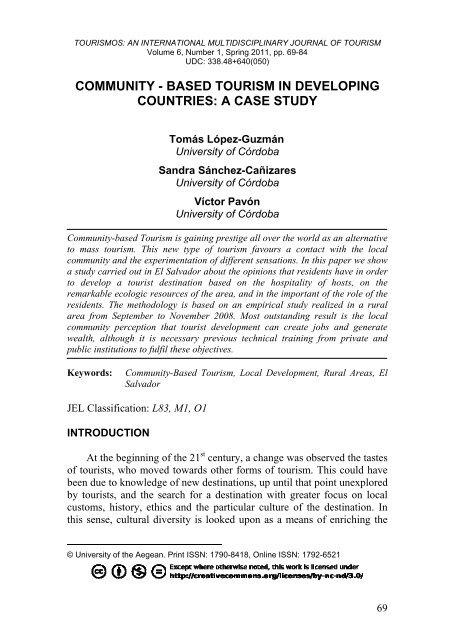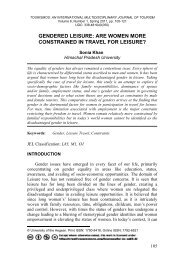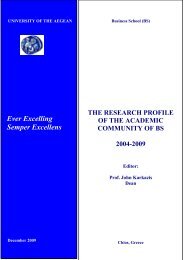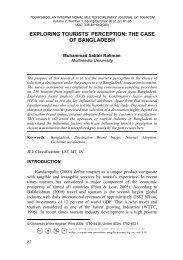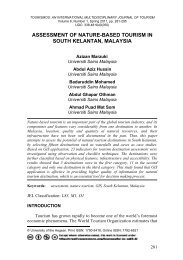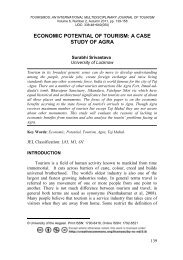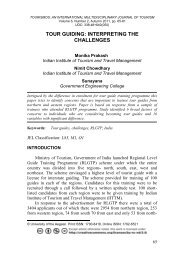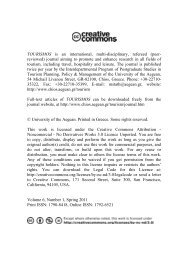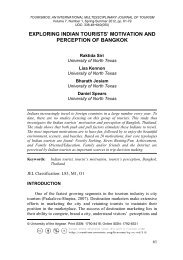COMMUNITY - BASED TOURISM IN DEVELOPING COUNTRIES: A ...
COMMUNITY - BASED TOURISM IN DEVELOPING COUNTRIES: A ...
COMMUNITY - BASED TOURISM IN DEVELOPING COUNTRIES: A ...
- No tags were found...
Create successful ePaper yourself
Turn your PDF publications into a flip-book with our unique Google optimized e-Paper software.
<strong>TOURISM</strong>OS: AN <strong>IN</strong>TERNATIONAL MULTIDISCIPL<strong>IN</strong>ARY JOURNAL OF <strong>TOURISM</strong>Volume 6, Number 1, Spring 2011, pp. 69-84UDC: 338.48+640(050)<strong>COMMUNITY</strong> - <strong>BASED</strong> <strong>TOURISM</strong> <strong>IN</strong> DEVELOP<strong>IN</strong>G<strong>COUNTRIES</strong>: A CASE STUDYTomás López-Guzmán 1University of CórdobaSandra Sánchez-CañizaresUniversity of CórdobaVíctor PavónUniversity of CórdobaCommunity-based Tourism is gaining prestige all over the world as an alternativeto mass tourism. This new type of tourism favours a contact with the localcommunity and the experimentation of different sensations. In this paper we showa study carried out in El Salvador about the opinions that residents have in orderto develop a tourist destination based on the hospitality of hosts, on theremarkable ecologic resources of the area, and in the important of the role of theresidents. The methodology is based on an empirical study realized in a ruralarea from September to November 2008. Most outstanding result is the localcommunity perception that tourist development can create jobs and generatewealth, although it is necessary previous technical training from private andpublic institutions to fulfil these objectives.Keywords:Community-Based Tourism, Local Development, Rural Areas, ElSalvadorJEL Classification: L83, M1, O1<strong>IN</strong>TRODUCTIONAt the beginning of the 21 st century, a change was observed the tastesof tourists, who moved towards other forms of tourism. This could havebeen due to knowledge of new destinations, up until that point unexploredby tourists, and the search for a destination with greater focus on localcustoms, history, ethics and the particular culture of the destination. Inthis sense, cultural diversity is looked upon as a means of enriching the© University of the Aegean. Print ISSN: 1790-8418, Online ISSN: 1792-652169
Tomás López-Guzmán, Sandra Sánchez-Cañizares & Víctor Pavónexperience of increasingly active tourists who are looking for newexperiences. On the one hand, al local level, opportunities have beenobserved to develop plans for the participation of new actors andstrategies, and for the involvement of civil corporations in thedevelopment process. On the other hand, tourism linked to a community´sinherent cultural and natural resources is on of the recurrent factors infostering the development of such communities. One means of managingthe coordination of the social and productive fabric of developingcountries is found in cooperatives and other associative forms of socialactor in different activities which are active in employment, such aswould be the case of tourism. However, one fundamental factor must bepointed out: the decision to exploit natural and cultural resources in orderto draw up development policies should come from local communitiesthemselves. Moreover, it is clear that two essential elements should betaken into consideration when measuring their impact (Nyaupane et al.,2006): firstly, the level of involvement of the local community and thelevel of control it has over tourism; secondly, the number and type oftourists. Thus, tourism is also considered as a tool in fighting poverty,with initiatives such as the World Tourism Organisation´s SustainableTourism-Eliminating Poverty (ST-EP) Programme.The World Tourism Organisation (2002) points out that sustainabletourism developed in certain geographical areas may become afundamental tool in the economic development of and the reduction ofpoverty in certain areas. It is possible to create businesses selling goodsand services by means of the area´s own cultural and environmentalresources, offering low scale opportunities for job creation, especially forwomen and young people. This would always be a complementaryactivity and never a substitution for primary sector activities. In thisrespect, the literature claims that promoting tourist exploitation ofunderdeveloped rural areas in Developing Countries is not, a priori, goodor bad, but depends on different political, cultural, social, economic andenvironmental factors.In this sense, several tourist destinations have been establishedthrough the structuring of tourism supply and demand. The need to breakwith routine, ensure customer satisfaction and change the monotony oftraditional tourism has fostered local initiatives incorporating naturalattractions and leisure activities at local level. The effect of all this is thatrural areas are undergoing a transformation which is changing both thelocal economic structure on the one hand and their traditional productionactivities on the other. These particular tourist initiatives have caused anatural repositioning of destination markets in accordance with70
<strong>TOURISM</strong>OS: AN <strong>IN</strong>TERNATIONAL MULTIDISCIPL<strong>IN</strong>ARY JOURNAL OF <strong>TOURISM</strong>Volume 6, Number 1, Spring 2011, pp. 69-84UDC: 338.48+640(050)fluctuations in demand, and have led to certain emerging destinationsbecoming attractive for increasingly specialised markets. Thus, it isevident that opportunities for new projects, such as tourist exploitation ofnatural, social and cultures resources, are coordinated al local level andare always complementary to the local economic structure, which is basedprimarily on agriculture and livestock farming. This implies that, in orderto implement a certain tourist product, there is a need to establish asuitable regional tourism policy based on three activities (Bringas andIsrael, 2004): first, training of local people and raising awareness; second,infrastructure and equipment; and third, promotion.In this paper, we present a study in which we analyse the extent towhich this new form of alternative tourism could generate vast incomingeconomic resources and create employment, with the basic premise beingthat it is complementary to (never a substitute for) other economicactivities, in rural or urban areas, based on the coordination of differenttourist destinations which combine natural resources and culturalelements. Similarly, we present a revision of the existing literature in thisfield related to the relationship between tourists and the local community,which is much more intense than in the case of traditional tourism (Zornand Farthing, 2007), mainly due to the involvement of hosts (Nyaupane etal., 2006; Lepp, 2007), and to the fact that seeking contact with othercultures is a fundamental element for its own development. Furthermore,we present the main results of a field study carried out in the so-calledFlowers Route in El Salvador (a small geographical area with very limitedeconomic development). The residents of this area were invited to expresstheir opinion on aspects related to this kind of tourism, and on thepossibility of creating cooperatives to encourage community tourism inthe area, by evaluating the advantages and disadvantages. The data fromthis field study has been analysed using various statistical andeconometric tools.LITERATURE REVIEWThe concept of Community-based Tourism (CBT) can be found inthe work of Murphy (1985), where aspects concerning tourism anddeveloping local communities are analysed, and in a further study by thesame author in 2004 (Murphy and Murphy, 2004). Along with these twostudies, there are several other research papers analysing the relationshipbetween tourism and local communities (such as Richards and Hall,2000). This concept paves the way for new lines of investigation and forthe possibility of tourism development together with other alternatives71
Tomás López-Guzmán, Sandra Sánchez-Cañizares & Víctor Pavónsuch as Pro-Poor Tourism (PPT); Community Benefit Tourist Initiatives(CBTIs) (Simpons, 2008); or Community-Based Enterprises (CBEs)(Manyara and Jones, 2007). To summarise, all these initiatives agree thatthe destination community should be included in the tourism planning andmanagement decision-making process, owed to three main reasons: itconsiders them to be part of the tourist product, local communities adaptto changes easily, and it helps to open their minds.Several projects based on CBT can be found in scientific literature: inAfrica (Lepp, 2007; Manyara and Jones, 2007; Kibicho, 2008), Asia(Nyaupane et al., 2006; Okazaki, 2008; Kayat, 2010), Oceania (Dyer etal., 2003), and in different countries of Latin America such as Brazil(Guerreiro, 2007), Ecuador (Ruiz et al., 2008), Mexico (Bringas andIsrael, 2004) and Peru (Zorn and Farthing, 2007).CBT is based on the active participation of the local community. Thisis why the creation of community events which may favour this type oftourism, while at the same time helping to create a relationship betweenthe local community and visitors, is so important. To facilitate this,different public administrations, Non-Governmental Organisations(NGOs), private institutions and the local community itself should getinvolved and work together. According to Nyaupane et al. (2006), themain limitations local communities have to face when implementingtourism projects are the following: lack of financial resources,infrastructure or know-how; limitations of a cultural kind; and potentialconflicts between the different public administrations. At the same time,the following factors are described as being highly important for CBTimplementation (Kibicho, 2008): the inclusion of stakeholders, theevaluation of individual and collective benefits, the setting of objectives,and analysis of decisions to be implemented. The main benefits ofcommunity tourism are the direct economic impact on families,socioeconomic improvements, and sustainable diversification of lifestyles(Manyara and Jones, 2007; Rastegar, 2010). CBT is certainly an effectiveway of implementing policy coordination, avoiding conflicts betweendifferent actors in tourism, and obtaining synergies based on the exchangeof knowledge, analysis and ability among all members of the community(Kibicho, 2008).On the other hand, it is necessary to study how the community as awhole participates in the development of the area as a tourist destination,mainly due to the following reasons (Briedenhann and Wickens, 2004):perception of tourism is based on the evaluation of the local community´sattitude (including the environment, infrastructure and events); theparticipation model of people in the local community exerts a powerful72
<strong>TOURISM</strong>OS: AN <strong>IN</strong>TERNATIONAL MULTIDISCIPL<strong>IN</strong>ARY JOURNAL OF <strong>TOURISM</strong>Volume 6, Number 1, Spring 2011, pp. 69-84UDC: 338.48+640(050)influence on the tourist´s experience; and tourism planning effects thecommunity as a whole.One of the most controversial aspects in scientific literature isdetermining the number and type of tourists. Thus, Nyaupane et al.(2006) highlight the importance of receiving a small number of tourists,which means more contact with local culture and society. This way, therisk of tourists invading private aspects of the local culture is avoided.However, at the same time, his limited number of visitors reduces theeconomic resources generated by tourism Having taken this element intoconsideration, the creation of cooperatives allowing the community tomanage its own tourist resources is seen a fundamental element (Lepp,2007; Gronau and Kaufmann, 2010). However, there are some negativeaspects in the development of the tourist product, including the potentiallink between a high number of tourists, sex and alcohol, and the loss ofcultural identity; and the hypothetical degradation of natural resources(Teye et al., 2002). In this case, residents have five alternatives tominimise this negative impact on the community – resistance, retreat,boundary maintenance, revitalisation and adoption (Dogan, 1989). Wemust remember that tourism can change (or event destroy) the localculture if it is being treated as just another tourist attraction and only aimsfor a rapid development of the area (Dyer et al., 2003).CBT is based on the creation of tourist products characterised bycommunity participation in their development. CBT emerged as apossible solution to the negative effects of mass tourism in developingcountries, and was, and the same time, a strategy for communityorganisation in order to attain better living conditions. Its core idea is theintegration of hotel management, food and beverages, complementaryservices and tourism management, but also includes other subsystems(infrastructure, health, education and environment) as maincharacteristics, thus presenting a sustainable development project createdby the community, and encouraging interrelation between the localcommunity and visitors as a key element in the development of a touristproduct (Cioce et al., 2007). CBT is protected and supported by differentinternational organisations, such as the World Tourism Organisation(2002), and has several objectives, among which communityempowerment and ownership, social and economic development,conservation of natural and cultural resources, and a high quality visitorexperience, should be noted.The structure of CBT can be broken down into four categories.Firstly, there are small tourist offices, which, in some cases, also work astourist guides, and whose relevance is not yet of high importance due to a73
Tomás López-Guzmán, Sandra Sánchez-Cañizares & Víctor Pavónlack of planning in the majority of the areas tourists visit. Secondly, thereare institutions which collaborate with the local tourism industry, mainlylocal public administrations, NGOs and universities. Thirdly, there aredirect service companies which can be further divided into two groups:accommodation and food and beverage; and shops selling local products,which are becoming increasingly important. Finally, there are varioustransport and financial businesses.We can conclude that the production chain in community tourism isgradually incorporating different actors which, one way or another, arebecoming part of the local tourist offer, the development of which ispresented in table 1.Table 1 Community tourism production chainPLANIFICATION ACTIVITIES FOOD ACCOMODATION TRANSPORTIt can be noted that the here most important links related to higherpresence of the local community in the chain, shown in table 1, aretransport, accommodation and food, whereas both links at the extreme ofthe chain are usually the weakest. The necessary assistance from publicadministrations, NGOs and universities is required for an adequateplanning of activities, together with necessary support from differentpublic and private institutions to develop tourist activities. Therefore, thesmall businesses to be created in the future in these areas should bediversified, not only offering accommodation and food services, but alsoworking with the sale of local products, tourist guides, complementaryactivities such as extreme or sports tourism, and in many cases, groundtransportation.DESCRIPTION OF THE GEOGRAPHICAL AREAEl Salvador is small country located in Central America with a totalarea of just under 21.000 km 2 , a population of nearly 6 million (althoughmany of its people live abroad) and a great variety and wealth of naturaland cultural attractions. At this point in time, El Salvador is still notrecognised at international level as a tourist destination, mainly as aconsequence of the armed conflict occurring between 1980 and 1992 andof the natural disasters which have recently affected the country (such ashurricane Mitch in 1998 or de 2001 earthquakes). Nevertheless, there isthe firm conviction on the part of the different public administrations to74
<strong>TOURISM</strong>OS: AN <strong>IN</strong>TERNATIONAL MULTIDISCIPL<strong>IN</strong>ARY JOURNAL OF <strong>TOURISM</strong>Volume 6, Number 1, Spring 2011, pp. 69-84UDC: 338.48+640(050)provide support to make El Salvador a quality international touristdestination.In table 2 we can see the number of foreign tourists visiting ElSalvador between 2004 and 2007, which shows a significant increasewithin this period.Table 2 Foreign tourists visiting in El Salvador 2004-2007Year 2004 2005 2006 2007Tourist 950.475 1.127.141 1.278.924 1.338.543Source: Ministry for Tourism of El Salvador (2008)According to data provided by the Ministry for Tourism of ElSalvador, in 2007, most tourists came from Central America (63.70%),followed by North America (28.88%). Furthermore, the number ofSalvadorian visitors living abroad (mainly in the USA) is very high(292.271 people). That is to say, 92.58% of tourists visiting the countrycome from two geographical areas. A tourist´s average expenditure is$90.10. The main reasons for visiting the country are to visit friends andfamily (33.7%), for a holiday (28.3%), and for business (25.6%).Similarly, according to El Salvador Ministry of Tourism figures, thecontribution of tourism to the national economy was estimated in 2007 tobe $940.6 million. This means that tourism produces more foreigncurrency income than traditional exports such as coffee ($187 million in2007), which is evidence of the attempts support this economic activity,as indicated above.The Ruta de las Flores (Flowers Route), the geographical area underanalysis, covers a route starting at Sonsonate and is made up of fiveplaces: Salcoatitán, Nahuizalco, Juayúa, Apaneca and Concepción deAtaco. A combination of tradition and history along with an outstandingnatural environment can be found along this route.When the field work for our research was carried out in this area,there were very few small hotels, with a total of 162 rooms. Twenty-threerestaurants can be also found on this route. It is worth noting theimportance of local communities in the food and beverage industrybecause the majority of restaurants are run by these local communities.The situation is somewhat different with respect to accommodation.Hotels are generally owned by international and national corporations.Similarly, in the field study we discovered that, as far as infrastructure inthe area is concerned, urban areas have drinking water and electricity,75
Tomás López-Guzmán, Sandra Sánchez-Cañizares & Víctor Pavónwhereas supply of these two vital elements is not guaranteed in ruralareas. It must also be noted that the treatment of waste and refuse needs tobe improved, in addition to better coordination of the financial system. Atthe time, there were serious deficiencies in medical care and publictransport, although serious attempts to improve them are in progress.METHODOLOGYTo carry out this research, an empirical study in the geographical areaof the Flowers Route in El Salvador was created. In this study, we havetried to determine the local community´s perception of itself, itsassessment of tourism in the area and of its potential improvement. Thesubjects of the study were residents in the area and a sample design wascarried out by means of randomised sampling. Population distributionwas always taken into account. The field work was carried out betweenSeptember and November 2008. Survey specifications can be seen intable 3.Table 3 Survey specificationsAreaFlowers RoutePopulationSampling60.000 people645 interviewsSimple error 3.84%ProcedureSimple randomised samplingPeriod September-November 2008Our instrument of research was a structured and closed questionnairemade up of three sections:• Section A. Socio-demographic profile or the surveyedgroup.76
Tomás López-Guzmán, Sandra Sánchez-Cañizares & Víctor Pavóndevelopment through tourism in the area) which activities wereconsidered to be increasing as a consequence of tourism development.The most common responses can be found in table 5. It is worth notingthat one of the objectives of the development of such activities throughcommunity-based tourism is the creation of companies which couldprovide a satisfactory response to specific visitor profiles.Table 5 Potential development of tourist activitiesActivity Men WomenAccommodation 27.1% 26.6%Food 11.6% 13.6%Craftwork 32.3% 39.0%Sports activities 24.2% 17.6%Other activities 4.8% 3.2%As shown in table 5, the activities which are expected to grow themost are craftwork sales and the creation of a network of accommodationfor visitors. It should be pointed out that, according to our research carriedout during the field study in this geographical area, accommodation isnormally run by national and international companies, which means thatimplementing community-based tourism could be a reasonable way forlocals to create their own hotels, with the aim of providing a betterresponse to the demands of visitors. Similarly, complementary activitieson offer and, in general, the development of sporting activities were alsohighlighted.The second aspect analysed in this investigation was the evaluation,by residents, of tourism resources in the area, as well as of infrastructureand other necessary elements for the development of tourism. The78
<strong>TOURISM</strong>OS: AN <strong>IN</strong>TERNATIONAL MULTIDISCIPL<strong>IN</strong>ARY JOURNAL OF <strong>TOURISM</strong>Volume 6, Number 1, Spring 2011, pp. 69-84UDC: 338.48+640(050)average evaluation of the area (1=poor; 3 =good) can be seen in table 6.As stated in scientific literature, the geographical area where communitybasedtourism can be implemented must possess resources attractive tovisitors. In addition to this, it is also necessary that the minimal conditionsin relation to infrastructure and other basic services can be found.However, as highlighted by Manyara and Jones (2007), community-basedtourism can also be the backbone for further generalised socio-economicdevelopment in the area and, subsequently, for the improvement ofinfrastructure to be used by the local community itself.Table 6 Average evaluation of tourist resourcesVARIABLE Average VARIABLE AverageKey factorsTourist servicesFees2.19Information2.33Hospitality2.59Accommodation2.55Environment2.27Food2.25General servicesActivitiesTransport links2.48Culture2.31Public safety2.07Stores2.52Cleaning2.14Ecology2.28Telecommunications2.46Wildlife2.37Food2.54Trekking2.21As shown in table 6, residents highly value the basics in thepromotion of a tourist destination. Hence, ecology, wildlife and trekking –basic resources in the development of the Flowers Route – obtainremarkable scores. Residents also believe that there would need to be animprovement in aspects such as public safety and cleanliness.The third characteristic analysed and put forward to residents in thearea during this investigation was who would, in their opinion, benefitmost if tourism was developed in the area. More precisely, threepossibilities were offered: the local community, the national government79
Tomás López-Guzmán, Sandra Sánchez-Cañizares & Víctor Pavónor private companies. A fourth alternative which encapsulated all three asa whole was also offered (table 7).Table 7 Beneficiaries of wealth generationMenWomenLocal community 13% 16%National Govt. 10.8% 8.3%Private Companies 22.9% 22.5%All of the above 53.3% 53.1%According to the data collected and displayed in table 7, residents inthe Flowers Route area believe that tourism implementation in the areawould mainly benefit private companies, although they also think that itcould have a very positive impact on the local community. It should behighlighted that, as stated by former studies (Briedenhann and Wickens,2004; Christou and Saveriades, 2010), it is very important that the localcommunity can see that the economic development of community-basedtourism generates benefits specifically for the local community.The fourth aspect analysed in this investigation was residents´opinions on whether they thought the creation of a tour route wouldgenerate wealth and create employment. Therefore, only the percentage ofpositive evaluations highlighted by residents in the local community withrespect to these two economic aspects is presented, since more that 90%believe that it would generate and 87.4% are of the opinion that it wouldcreate employment. It is interesting to discover that the majority of thosepolled highlight the establishment of tour routes as very beneficial for thearea.The fifth aspect under analysis the knowledge of residents in the areawith respect to the level of training and ability in matters directly relatedto tourist activities. The main results are displayed in table 8.80
<strong>TOURISM</strong>OS: AN <strong>IN</strong>TERNATIONAL MULTIDISCIPL<strong>IN</strong>ARY JOURNAL OF <strong>TOURISM</strong>Volume 6, Number 1, Spring 2011, pp. 69-84UDC: 338.48+640(050)Table 8 Perception of knowledge of tourist mattersMenWomenNon Existent 7.3% 8.9%Poor 51.9% 51.4%Adequate 40.8% 39.7%Table 8 shows that the community does not perceive its training andsubsequent knowledge to be sufficient for the development of touristactivities in an area managed by its own residents. Furthermore, thisresearch finds that, in the opinion of those surveyed, public institution(59%), private companies (29.1%), and NGOs and universities (11.5%)should be the ones to provide residents with the necessary training to puttourism development into action. Therefore, this kind of responsehighlights the indispensable link between community-based touristactivities and improvement of quality of life through education. It isworth noting the incredibly important role to be played by NGOs anduniversities in the improvement of the educational levels of local peopleby bettering their technical qualifications.CONCLUSIONCommunity-based tourism is present in many different geographicalareas of the world, in particular in developing countries. It was created asa different way to look for alternatives to traditional mass tourism, and itis giving rise to the creation of specific destinations which permits thegeneration of wealth for local communities and the creation of jobs. Itshould be seen as an activity which is complementary to, and never asubstitute for, traditional activities based primarily on agriculture, fishing,and livestock farming.81
Tomás López-Guzmán, Sandra Sánchez-Cañizares & Víctor PavónIn this paper, we have presented research into a specific geographicalarea know as the Flowers Route in El Salvador, where a project supportedby public institutions in collaboration with different NGOs andSalvadorian and Spanish universities is being developed in order to createspecific infrastructure in the area. However, in relation to tourism, thiswould be framed within a more ambitious project where the residentsthemselves could set out the guidelines for tourism development.The main outcomes of this study show that this type of tourism isassessed by the local community in a very positive way, because it isperceived as a way of generating economic benefits and, at the same time,creating new jobs. In this sense, it is important to highlight the role ofwomen (and young people) as crucial actors in the planning anddevelopment of tourist activities, and in the management of prospectivebusinesses. Similarly, the development of tourism would mean thecreation of resources (such as health services, education andinfrastructure) for the community itself.Finally, one major conclusion can be drawn from this survey: thelocal community is very much aware of the fact that it currently does nothave the adequate training, education and qualifications to face thechallenge of constructing good quality tourism products. Given thissituation, NGOs and other institutions such as universities, both nationaland foreign, could perform a leading role in the training of local residents.REFERENCESBriedenhann, J. & Wickens, E. (2004). Tourism routes as a tool for the economicdevelopment of rural areas-vibrant hope or impossible dream? TourismManagement, Vol. 25, No.1, pp.71-79.Bringas, N. & Israel, J.I. (2004). El turismo alternativo: una opción para eldesarrollo local en dos comunidades indígenas de Baja California.Economía, Sociedad y Territorio, Vol. 4, No.15, pp.551-588.Cioce, C.A., Bona, M. & Ribeiro, F. (2007). Community tourism: montanha beijaflordourado pilot project (microbasin of the sagrado river, Morretes,Paraná). Turismo-Visao e Açao, Vol. 9, No.2, pp.249-266.Christou, P. & Saveriades, A. (2010). The use of ethnography to explore touristsatisfaction antecedents. Tourismos, Vol. 5, No.1, pp.89-100.Dogan, H.Z. (1989). Forms of adjustment: Socio-cultural impacts of tourism.Annals of Tourism Research, Vol. 16, No.2, pp.216-236.Dyer, P., Aberdeen, L. & Schuler, S. (2003). Tourism impacts on an Australianindigenous community: a Djabugay case study. Tourism Management,Vol. 24, No.1, pp.83-95.82
<strong>TOURISM</strong>OS: AN <strong>IN</strong>TERNATIONAL MULTIDISCIPL<strong>IN</strong>ARY JOURNAL OF <strong>TOURISM</strong>Volume 6, Number 1, Spring 2011, pp. 69-84UDC: 338.48+640(050)Gronau, W. & Kaufmann, R. (2010). Tourism as a stimulus for sustainabledevelopment in rural areas: A Cypriot perspective. Tourismos, Vol. 4,No.1, pp.83-96.Guerreiro, E.M. (2007). O turismo como agente de desenvolvimento social e acomunidade Guarani nas Ruínas Jesuíticas de Sao Migueldas Misses.Revista de Turismo y Patrimonio Cultural, Vol. 5, No.3, pp.343-352.Kibicho, W. (2008). Community-based tourism: A factor-cluster segmentationapproach. Journal of Sustainable Tourism, Vol. 16, No.2, pp.211-231.Kayat, K. (2010). The nature of cultural contribution of a community-basedhomestay programme. Tourismos, Vol. 5, No.2, pp.145-159.Lepp, A. (2007). Residents´attitudes towards tourism in Bigodi village, Uganda.Tourism Management, Vol.28, No.3, pp.876-885.Manyara, G. & Jones, E. (2007). Community-based tourism enterprisesdevelopment in Kenya: An exploration of their potential as avenues ofpoverty reduction. Journal of Sustainable Tourism, Vol. 15, No.6, pp.628-644.Murphy, P.E. (1985). Tourism: A community approach. London, Methuen.Murphy, P.E. & Murphy, A.E. (2004). Strategic management for tourismcommunities: Bridging the gaps. Clevedon, Aspects of Tourism SeriesChannel view Publications.Nyaupane, G.P., Morais, D.B. & Dowler, L. (2006). The role of communityinvolvement and number/type of visitors on tourism impacts: A controlledcomparison of Annapurna, Nepal and Northwest Yunna, China. TourismManagement, Vol. 27, No. 6, pp.1373-1385.Okazaki, E. (2008). A community-based tourism model. Its conception and use.Journal of Sustainable Tourism, Vol. 16, No.5, pp.511-529.Rastegar, H. (2010). Tourism development and residents' attitude: A case study ofYazd, Iran. Tourismos, Vol. 5, No.2, pp. 203-211.Richards, G. & Hall, D. (2000). Tourism and sustainable community development.London, Routledge.Ruiz, E., Hernández, M., Coca, A., Cantero, P. & Campo, A. (2008). Turismocomunitario en Ecuador. Comprendiendo el community-based tourismdesde la comunidad. Revista de Turismo y Patrimonio Cultural, Vol. 6,No.3, pp.399-418.Simpson, M.C. (2008). Community benefit tourism initiatives- A conceptualoxymoron? Tourism Management, Vol. 29, No.1, pp.1-18.Teye, V., Sonmez, S. & Sirakaya E. (2002). Residents´attitudes toward tourismdevelopment. Annals of Tourism Research, Vol. 29, No.3, pp.668-688.World Tourism Organization. (2002). Tourism and poverty alleviation. Madrid,World Tourism Organization.Zorn, E. & Farthing, L.E. (2007). Communitarian tourism. Hosts and mediators inPeru. Annals of Tourism Research, Vol. 34, No.3, pp.673-689.83
Tomás López-Guzmán, Sandra Sánchez-Cañizares & Víctor PavónENDNOTES1. This Research is supported by the Cooperation Area of University ofCordoba (Spain).SUBMITTED: MAY 2010REVISION SUBMITTED: AUGUST 2010ACCEPTED: SEPTEMBER 2010REFEREED ANONYMOUSLYTomás López-Guzmán (tomas.lopez@uco.es) is a Lecturer at Universityof Cordoba, Department of Applied Economics, Faculty of Law andEconomics. 14071-Cordoba, Spain.Sandra Sánchez-Cañizares (sandra.sanchez@uco.es) is a Lecturer atUniversity of Cordoba, Department of Business Administration, Facultyof Law and Economics, 14071-Cordoba, Spain.Víctor Pavón (si1pavav@uco.es) is a Lecturer at University of Cordoba,Department of Modern Languages, Faculty of Philology, 14071-Cordoba,Spain.84


